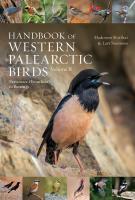Behavioural Ecology of Western Palearctic Falcons 303060540X, 9783030605407
This monograph is the result of eight years of bibliographical and field research concerning several behavioural ecology
269 99 8MB
English Pages 206 [214] Year 2021
Table of contents :
Preface
References
Acknowledgements
Contents
Chapter 1: Western Palearctic Falcons
1.1 The Falconidae Family
1.1.1 The Genus Falco
1.1.2 Subspecies
1.1.3 Endemic Subspecies
1.1.4 Hybrids
1.2 Plumage and Bare Parts
1.2.1 Pigmentary Colours
1.2.1.1 Melanin
1.2.1.2 Carotenoids
1.2.2 Polymorphism
1.2.3 Effects of Melanin- and Carotenoid-Based Colouration
1.2.3.1 Melanin
1.2.3.2 Carotenoids
1.3 Reversed Size Dimorphism
1.4 Flight Performances
1.5 Vision
1.6 Behavioural Repertoire of Falcons
References
Chapter 2: Reproductive Strategies
2.1 The Breeding Life History Stage
2.2 Developmental Phase
2.2.1 Photoperiod
2.2.2 Moult
2.2.3 Food Availability During the Developmental Phase
2.2.4 Weather Effects
2.3 The Breeding Population
2.3.1 First Year and Second Calendar Year Breeders
2.3.2 Inbreeding
2.3.3 Polyandry, Polygyny, and Cooperative Breeding
2.3.4 Full Adults Non-breeders
2.4 Mate Choice
2.4.1 Copulation and Extra-Pair Fertilization
2.4.2 Assortative Mating: Heterozygosity
2.4.3 Early Mate Replacement
2.5 Nest-Site Choice
2.5.1 Height and Slope
2.5.2 Aspect
2.5.3 Nest Structure
2.5.4 Public Information
2.5.5 Area Surrounding the Nest
2.5.6 Occupancy and Alternative Nest Sites
2.6 Egg-Laying
2.6.1 Early and Late Breeding
2.6.2 Maternal Resources
2.6.3 Eggs
2.6.3.1 Eggshells
2.6.4 Re-laying
2.7 Clutch Size
2.7.1 Extra Eggs
2.8 Incubation
2.8.1 Desertion
2.9 Hatching
2.9.1 Hatching Failures
2.9.2 Hatching Asynchrony
2.10 Nestlings
2.10.1 Growth of Nestlings
2.10.2 Relationships Between Survival and Environmental Conditions
2.10.2.1 Nestlings Mortality
2.10.3 Sex Ratio
2.10.4 Siblicide, Cannibalism, Infanticide, and Conspecific Nest Predation
2.10.5 Adoptions of Nestlings
2.10.6 Parasites and Infectious Diseases
2.10.6.1 MHC
2.11 Parental Care and Investment
2.11.1 Role Specialization
2.11.2 Prey Provisioning
2.11.3 Parental Investment
2.11.4 Parental Favouritism
2.11.5 Helpers
2.12 Fledglings
2.12.1 Post-fledging Dependence Period
2.13 Turnover and Recruitment
2.14 Total Failures
References
Chapter 3: Competition and Defence
3.1 Introduction
3.2 Abundance and Population Dynamics
3.3 Breeding Dispersal and Territoriality
3.3.1 The Nearest Neighbour Distance (NDD)
3.4 Nest Defence by Parents
3.5 Interspecific Interactions
3.5.1 Predator–Prey Association
3.5.2 Sympatric Falcons
3.5.3 Intra-guild Kleptoparasitism
3.5.4 Proximity with Other Competitors
3.5.5 Intra-guild Predation
References
Chapter 4: Exploitation of Resources
4.1 Introduction
4.2 Anatomical and Physiological Adaptations
4.2.1 Shape of Beaks, Prey Handling, and Prey Consumption
4.2.2 Pellets
4.2.3 Energetics
4.3 Diet
4.3.1 Seasonal Variation in Diet
4.4 Foraging Area
4.5 Hunting Techniques
4.5.1 Aerial Attacks
4.5.2 Crepuscular and Nocturnal Hunting Activities
4.5.3 Cooperative Hunting
4.5.4 Surprise Attack
4.5.5 Kleptoparasitism
4.5.6 Scavenging
4.6 Prey
4.6.1 Prey Choice
4.6.2 Predator/Prey Relationship
4.6.2.1 Synchronization
4.6.2.2 Anti-predator Strategies
4.6.2.3 Preferred Prey Fluctuation
References
Chapter 5: Dispersal Patterns
5.1 Introduction
5.2 Individual Conditions
5.3 Individual Decisions
5.4 Juvenile Dispersal
5.5 Philopatry
5.6 Seasonal Movements
5.7 Pre-migration
5.8 Constraints
5.8.1 Barriers
5.8.2 Weather Conditions
5.9 Long Movements
5.9.1 Nocturnal Flights
5.9.2 Feeding Habits during Migration
5.10 Wintering
References
Chapter 6: Communication
6.1 Signals
6.2 Plumage Colouration
6.2.1 Juvenile Plumage and Delayed Plumage Maturation
6.2.2 Sexual Dichromatism
6.2.3 Sexual Monochromatism
6.2.4 Polymorphism
6.2.5 Sexual Ornaments
6.3 Skin Colouration
6.4 Parental–Offspring Communication
6.5 Calls
6.6 Courtship Displays and Pair Bonding
References
Chapter 7: Living in Groups
7.1 Introduction
7.2 Coloniality
7.2.1 Occupation
7.2.2 Costs and Benefits
7.2.3 Effects of Climate and Land Use
7.2.4 Colony Dynamics
7.2.5 Inter-Colony Movements
7.2.6 Prey Depletion Around the Colony
7.2.7 Paternal Assurance and Extra-Pair Fertilization Inside a Colony
7.3 Artificial Colonies
7.4 Mixed Species Colonies
7.5 Nonreproductive Stage
References
Index
Preface
References
Acknowledgements
Contents
Chapter 1: Western Palearctic Falcons
1.1 The Falconidae Family
1.1.1 The Genus Falco
1.1.2 Subspecies
1.1.3 Endemic Subspecies
1.1.4 Hybrids
1.2 Plumage and Bare Parts
1.2.1 Pigmentary Colours
1.2.1.1 Melanin
1.2.1.2 Carotenoids
1.2.2 Polymorphism
1.2.3 Effects of Melanin- and Carotenoid-Based Colouration
1.2.3.1 Melanin
1.2.3.2 Carotenoids
1.3 Reversed Size Dimorphism
1.4 Flight Performances
1.5 Vision
1.6 Behavioural Repertoire of Falcons
References
Chapter 2: Reproductive Strategies
2.1 The Breeding Life History Stage
2.2 Developmental Phase
2.2.1 Photoperiod
2.2.2 Moult
2.2.3 Food Availability During the Developmental Phase
2.2.4 Weather Effects
2.3 The Breeding Population
2.3.1 First Year and Second Calendar Year Breeders
2.3.2 Inbreeding
2.3.3 Polyandry, Polygyny, and Cooperative Breeding
2.3.4 Full Adults Non-breeders
2.4 Mate Choice
2.4.1 Copulation and Extra-Pair Fertilization
2.4.2 Assortative Mating: Heterozygosity
2.4.3 Early Mate Replacement
2.5 Nest-Site Choice
2.5.1 Height and Slope
2.5.2 Aspect
2.5.3 Nest Structure
2.5.4 Public Information
2.5.5 Area Surrounding the Nest
2.5.6 Occupancy and Alternative Nest Sites
2.6 Egg-Laying
2.6.1 Early and Late Breeding
2.6.2 Maternal Resources
2.6.3 Eggs
2.6.3.1 Eggshells
2.6.4 Re-laying
2.7 Clutch Size
2.7.1 Extra Eggs
2.8 Incubation
2.8.1 Desertion
2.9 Hatching
2.9.1 Hatching Failures
2.9.2 Hatching Asynchrony
2.10 Nestlings
2.10.1 Growth of Nestlings
2.10.2 Relationships Between Survival and Environmental Conditions
2.10.2.1 Nestlings Mortality
2.10.3 Sex Ratio
2.10.4 Siblicide, Cannibalism, Infanticide, and Conspecific Nest Predation
2.10.5 Adoptions of Nestlings
2.10.6 Parasites and Infectious Diseases
2.10.6.1 MHC
2.11 Parental Care and Investment
2.11.1 Role Specialization
2.11.2 Prey Provisioning
2.11.3 Parental Investment
2.11.4 Parental Favouritism
2.11.5 Helpers
2.12 Fledglings
2.12.1 Post-fledging Dependence Period
2.13 Turnover and Recruitment
2.14 Total Failures
References
Chapter 3: Competition and Defence
3.1 Introduction
3.2 Abundance and Population Dynamics
3.3 Breeding Dispersal and Territoriality
3.3.1 The Nearest Neighbour Distance (NDD)
3.4 Nest Defence by Parents
3.5 Interspecific Interactions
3.5.1 Predator–Prey Association
3.5.2 Sympatric Falcons
3.5.3 Intra-guild Kleptoparasitism
3.5.4 Proximity with Other Competitors
3.5.5 Intra-guild Predation
References
Chapter 4: Exploitation of Resources
4.1 Introduction
4.2 Anatomical and Physiological Adaptations
4.2.1 Shape of Beaks, Prey Handling, and Prey Consumption
4.2.2 Pellets
4.2.3 Energetics
4.3 Diet
4.3.1 Seasonal Variation in Diet
4.4 Foraging Area
4.5 Hunting Techniques
4.5.1 Aerial Attacks
4.5.2 Crepuscular and Nocturnal Hunting Activities
4.5.3 Cooperative Hunting
4.5.4 Surprise Attack
4.5.5 Kleptoparasitism
4.5.6 Scavenging
4.6 Prey
4.6.1 Prey Choice
4.6.2 Predator/Prey Relationship
4.6.2.1 Synchronization
4.6.2.2 Anti-predator Strategies
4.6.2.3 Preferred Prey Fluctuation
References
Chapter 5: Dispersal Patterns
5.1 Introduction
5.2 Individual Conditions
5.3 Individual Decisions
5.4 Juvenile Dispersal
5.5 Philopatry
5.6 Seasonal Movements
5.7 Pre-migration
5.8 Constraints
5.8.1 Barriers
5.8.2 Weather Conditions
5.9 Long Movements
5.9.1 Nocturnal Flights
5.9.2 Feeding Habits during Migration
5.10 Wintering
References
Chapter 6: Communication
6.1 Signals
6.2 Plumage Colouration
6.2.1 Juvenile Plumage and Delayed Plumage Maturation
6.2.2 Sexual Dichromatism
6.2.3 Sexual Monochromatism
6.2.4 Polymorphism
6.2.5 Sexual Ornaments
6.3 Skin Colouration
6.4 Parental–Offspring Communication
6.5 Calls
6.6 Courtship Displays and Pair Bonding
References
Chapter 7: Living in Groups
7.1 Introduction
7.2 Coloniality
7.2.1 Occupation
7.2.2 Costs and Benefits
7.2.3 Effects of Climate and Land Use
7.2.4 Colony Dynamics
7.2.5 Inter-Colony Movements
7.2.6 Prey Depletion Around the Colony
7.2.7 Paternal Assurance and Extra-Pair Fertilization Inside a Colony
7.3 Artificial Colonies
7.4 Mixed Species Colonies
7.5 Nonreproductive Stage
References
Index

- Author / Uploaded
- Giovanni Leonardi
![Behavioural Ecology of Western Palearctic Falcons [1st ed.]
9783030605407, 9783030605414](https://ebin.pub/img/200x200/behavioural-ecology-of-western-palearctic-falcons-1st-ed-9783030605407-9783030605414.jpg)
![Handbook of Western Palearctic Birds [2]
9781472960924, 9781472937377, 9781472937575, 9781472937360](https://ebin.pub/img/200x200/handbook-of-western-palearctic-birds-2-9781472960924-9781472937377-9781472937575-9781472937360.jpg)




![Continental Northeast Asian Amphibians: Origins, Behavioural Ecology, and Conservation [1 ed.]
0323918573, 9780323918572](https://ebin.pub/img/200x200/continental-northeast-asian-amphibians-origins-behavioural-ecology-and-conservation-1nbsped-0323918573-9780323918572.jpg)
![Continental Northeast Asian Amphibians: Origins, Behavioural Ecology, and Conservation [1 ed.]
0323918573, 9780323918572](https://ebin.pub/img/200x200/continental-northeast-asian-amphibians-origins-behavioural-ecology-and-conservation-1nbsped-0323918573-9780323918572-a-7142483.jpg)

